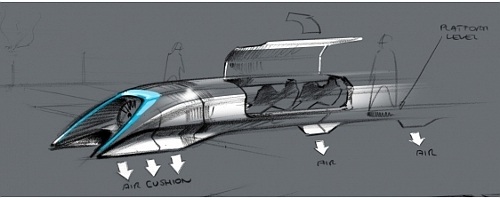Is Hyperloop the transport of the future?
When the California ‘high speed’ rail was approved, I was quite disappointed, as I know many others were too. How could it be that the home of Silicon Valley and JPL – doing incredible things like indexing all the world’s knowledge and putting rovers on Mars – would build a bullet train that is both one of the most expensive per mile and one of the slowest in the world? Note, I am hedging my statement slightly by saying “one of”.
The head of the California high speed rail project called me to complain that it wasn’t the very slowest bullet train, nor the very most expensive per mile.
The underlying motive for a statewide mass transit system is a good one. It would be great to have an alternative to flying or driving, but obviously only if it is actually better than flying or driving. The train in question would be both slower, more expensive to operate (if unsubsidised) and less safe by two orders of magnitude than flying, so why would anyone use it?
If we are to make a massive investment in a new transportation system, then the return should by rights be equally massive. Compared to the alternatives, it should ideally be:
-- Safer.
-- Faster.
-- Lower cost.
-- More convenient.
-- Immune to weather.
-- Sustainably self-powering.
-- Resistant to Earthquakes.
-- Not disruptive to those along the route.
Is there truly a new mode of transport – a fifth mode after planes, trains, cars and boats – that meets those criteria and is practical to implement? Many ideas for a system with most of those properties have been proposed and should be acknowledged, reaching as far back as Robert Goddard’s to proposals in recent decades by the Rand Corporation and ET3.
Unfortunately, none of these have panned out. As things stand today, there is not even a short distance demonstration system operating in test pilot mode anywhere in the world, let alone something that is robust enough for public transit. They all possess, it would seem, one or more fatal flaws that prevent them from coming to fruition.
Constraining the Problem
The Hyperloop (or something similar) is, in my opinion, the right solution for the specific case of high traffic city pairs that are less than about 1500 km or 900 miles apart. Around that inflection point, I suspect that supersonic air travel ends up being faster and cheaper.
With a high enough altitude and the right geometry, the sonic boom noise on the ground would be no louder than current airliners, so that isn’t a showstopper. Also, a quiet supersonic plane immediately solves every long distance city pair without the need for a vast new worldwide infrastructure.
However, for a sub several hundred mile journey, having a supersonic plane is rather pointless, as you would spend almost all your time slowly ascending and descending and very little time at cruise speed. In order to go fast, you need to be at high altitude where the air density drops exponentially, as air at sea level becomes as thick as molasses (not literally, but you get the picture) as you approach sonic velocity.
Hyperloop Transportation System
Hyperloop is a proposed transportation system for travelling between Los Angeles, California, and San Francisco, California in 35 minutes.

The Hyperloop consists of several distinct components, including:
1. Capsule:
a. Sealed capsules carrying 28 passengers each that travel along the interior of the tube depart on average every two minutes from Los Angeles or San Francisco (up to every 30 seconds during peak usage hours).
b. A larger system has also been sized that allows transport of three full size automobiles with passengers to travel in the capsule.
c. The capsules are separated within the tube by approximately 23 miles (37 km) on average during operation.
d. The capsules are supported via air bearings that operate using a compressed air reservoir and aerodynamic lift.
2. Tube:
a. The tube is made of steel. Two tubes will be welded together in a side by side configuration to allow the capsules to travel both directions.
b. Pylons are placed every 100 ft (30 metres) to support the tube.
c.Solar arrays will cover the top of the tubes in order to provide power to the system.
3. Propulsion:
a.Linear accelerators are constructed along the length of the tube at various locations to accelerate the capsules.
b. Stators are located on the capsules to transfer momentum to the capsules via the linear accelerators.
4. Route:
a. There will be a station at Los Angeles and San Francisco. Several stations along the way will be possible with splits in the tube.
b. The majority of the route will follow I-5 and the tube will be constructed in the median.
The Hyperloop is sized to allow expansion as the network becomes increasingly popular. The capacity would be 840 passengers per hour which more than sufficient to transport all of the six million passengers travelling between Los Angeles and San Francisco are as per year. In addition, this accounts for 70 per cent of those travellers to use the Hyperloop during rush hour.
The lower cost of travelling on Hyperloop is likely to result in increased demand, in which case the time between capsule departures could be significantly shortened.
The model for the Hyperloop is laid out in full detail by Elon Musk here.
This article was originally published on the Tesla Motors blog.













